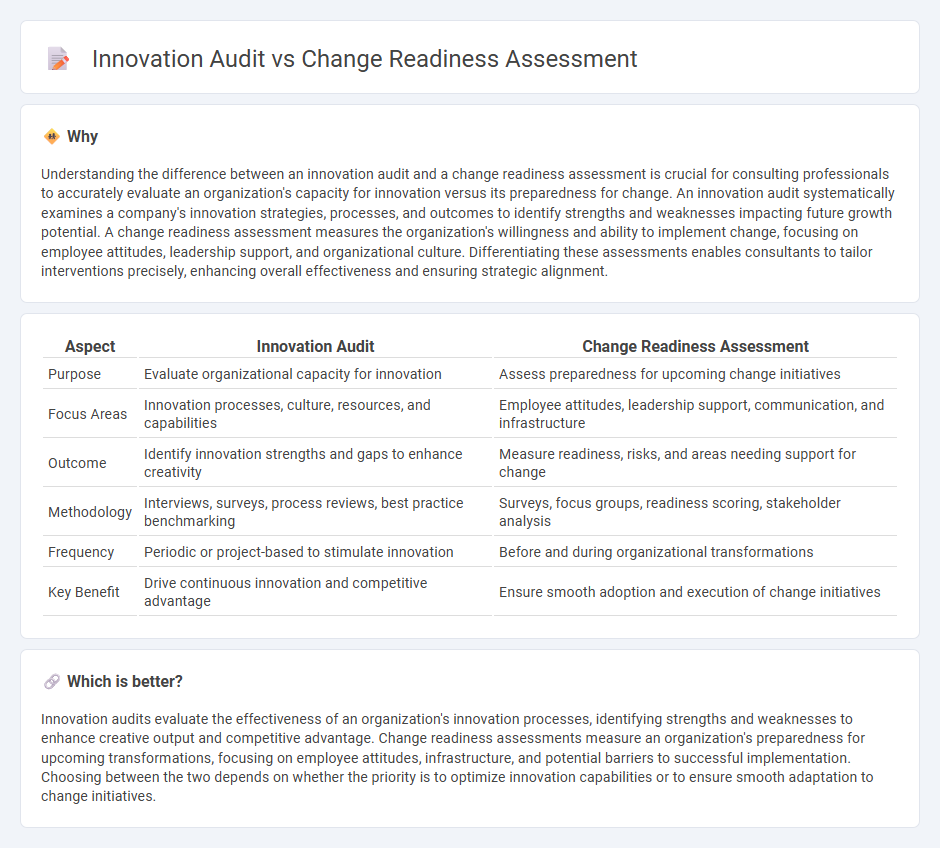
Innovation audits evaluate an organization's ability to generate and implement new ideas by assessing processes, culture, and resources. Change readiness assessments measure how prepared employees and systems are to adopt and sustain upcoming transformations. Explore these tools to enhance your company's adaptability and growth potential.
Why it is important
Understanding the difference between an innovation audit and a change readiness assessment is crucial for consulting professionals to accurately evaluate an organization's capacity for innovation versus its preparedness for change. An innovation audit systematically examines a company's innovation strategies, processes, and outcomes to identify strengths and weaknesses impacting future growth potential. A change readiness assessment measures the organization's willingness and ability to implement change, focusing on employee attitudes, leadership support, and organizational culture. Differentiating these assessments enables consultants to tailor interventions precisely, enhancing overall effectiveness and ensuring strategic alignment.
Comparison Table
| Aspect | Innovation Audit | Change Readiness Assessment |
|---|---|---|
| Purpose | Evaluate organizational capacity for innovation | Assess preparedness for upcoming change initiatives |
| Focus Areas | Innovation processes, culture, resources, and capabilities | Employee attitudes, leadership support, communication, and infrastructure |
| Outcome | Identify innovation strengths and gaps to enhance creativity | Measure readiness, risks, and areas needing support for change |
| Methodology | Interviews, surveys, process reviews, best practice benchmarking | Surveys, focus groups, readiness scoring, stakeholder analysis |
| Frequency | Periodic or project-based to stimulate innovation | Before and during organizational transformations |
| Key Benefit | Drive continuous innovation and competitive advantage | Ensure smooth adoption and execution of change initiatives |
Which is better?
Innovation audits evaluate the effectiveness of an organization's innovation processes, identifying strengths and weaknesses to enhance creative output and competitive advantage. Change readiness assessments measure an organization's preparedness for upcoming transformations, focusing on employee attitudes, infrastructure, and potential barriers to successful implementation. Choosing between the two depends on whether the priority is to optimize innovation capabilities or to ensure smooth adaptation to change initiatives.
Connection
Innovation audit identifies gaps in an organization's current innovation processes, while change readiness assessment evaluates the organization's capacity to implement necessary changes effectively. Together, these evaluations provide a comprehensive understanding of both innovation potential and the organizational adaptability required for successful transformation. This interconnected analysis enables targeted strategies that enhance innovation outcomes by aligning processes with change management capabilities.
Key Terms
Change Readiness Assessment:
Change Readiness Assessment evaluates an organization's capacity to adopt and implement change by analyzing employee attitudes, organizational culture, and existing processes. It identifies potential resistance and areas requiring support to ensure smooth transitions and sustainable improvement. Explore further to understand how a Change Readiness Assessment can enhance your transformation initiatives.
Stakeholder Engagement
Change readiness assessment evaluates stakeholders' willingness and capacity to adapt to organizational transformations by measuring communication effectiveness, motivation levels, and resistance factors. Innovation audit examines stakeholders' involvement in ideation, collaboration, and support for new initiatives to gauge the innovation culture and ecosystem. Explore more to understand how each approach drives stakeholder engagement and organizational success.
Organizational Culture
Change readiness assessment evaluates how prepared an organization is to implement change by examining employee attitudes, leadership support, and communication effectiveness within the current organizational culture. Innovation audit measures the culture's capacity for creativity, risk-taking, and experimentation, identifying cultural barriers that hinder innovative behaviors and idea generation. Explore these tools to understand how your organization's culture influences both change initiatives and innovation potential.
Source and External Links
How To Conduct a Change Readiness Assessment [+ Template] - A change readiness assessment evaluates how prepared an organization, teams, and individuals are to adopt and sustain change, focusing on aspects like awareness, motivation, knowledge, ability, and reinforcement aligned with models such as ADKAR and Kotter's 8-Step Change Model.
How to Conduct a Change Readiness Assessment - Whatfix - This outlines an 8-step process for conducting change readiness assessments, including defining objectives, collecting relevant data, and using this data to measure how prepared employees and the organization are for change initiatives.
How to Use a Readiness Assessment For Change Management - Change readiness assessments systematically evaluate an organization's preparedness for change by analyzing data such as surveys and leadership feedback to identify readiness levels, barriers, and develop targeted strategies for successful change implementation.
 dowidth.com
dowidth.com